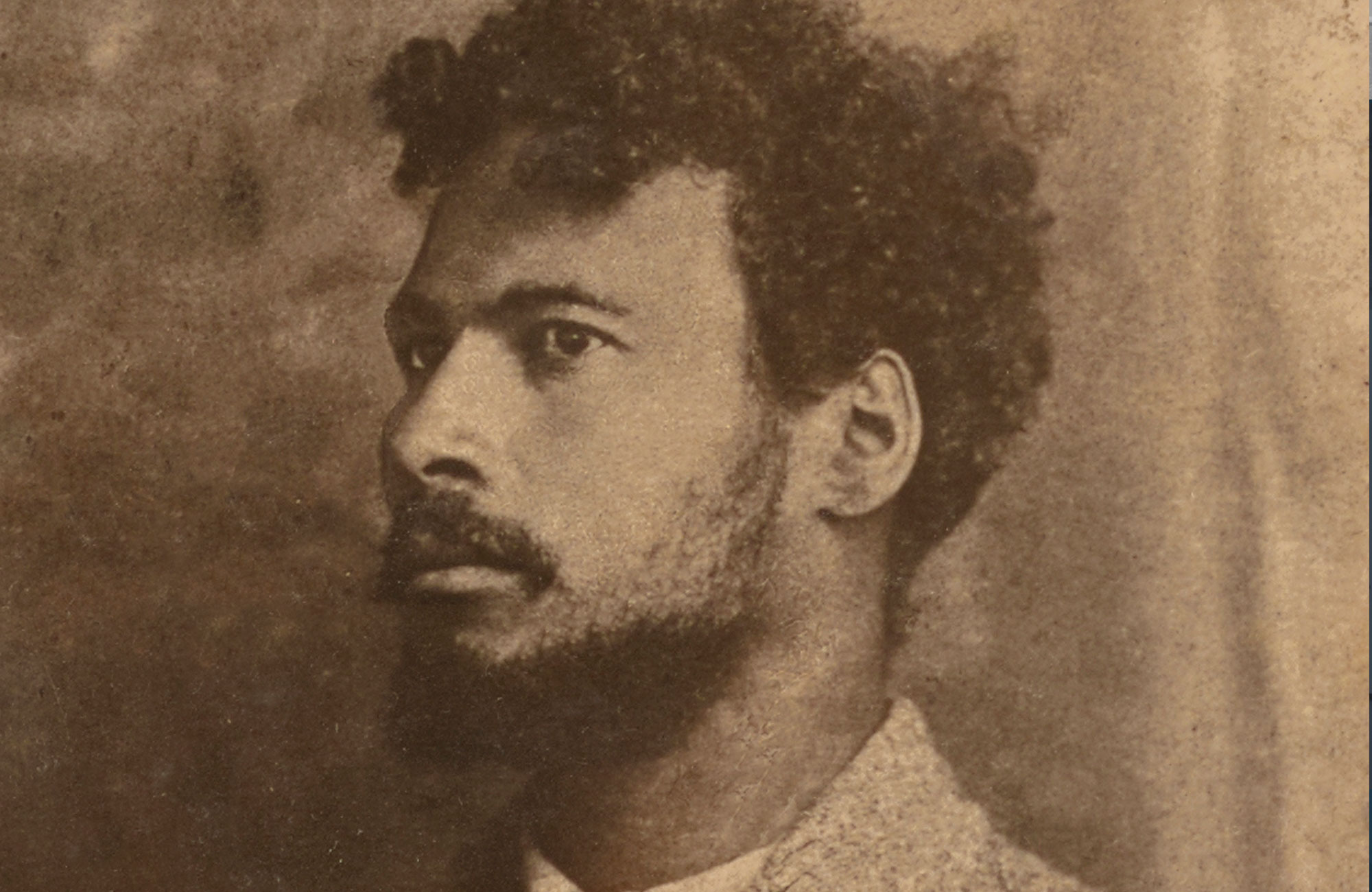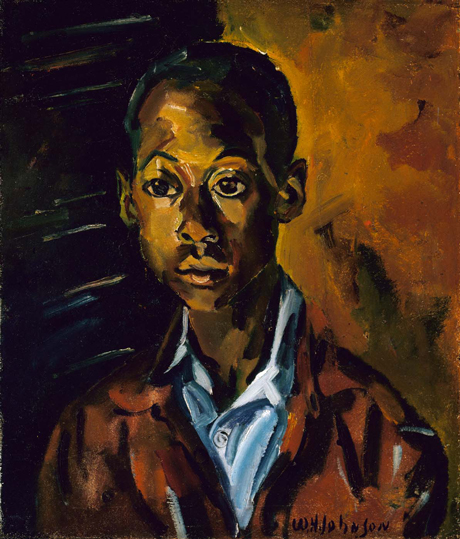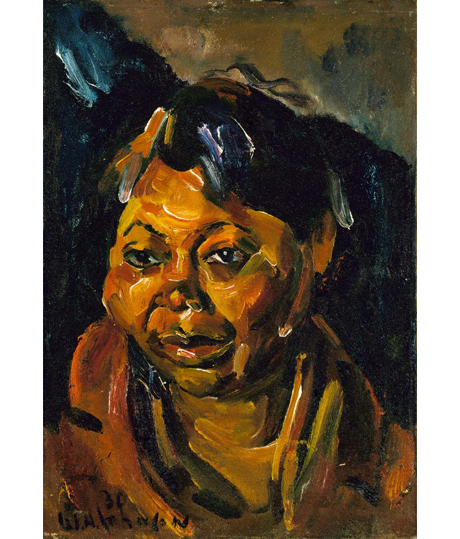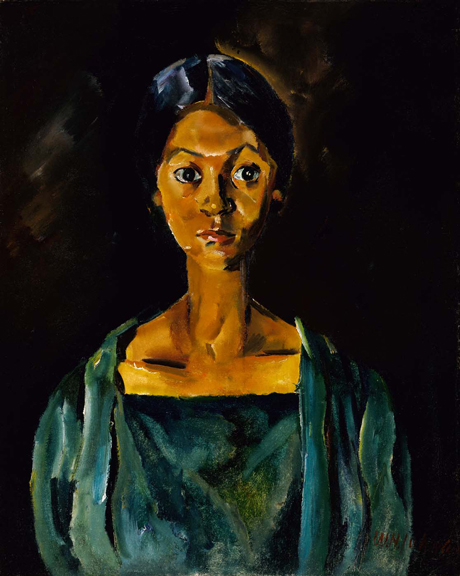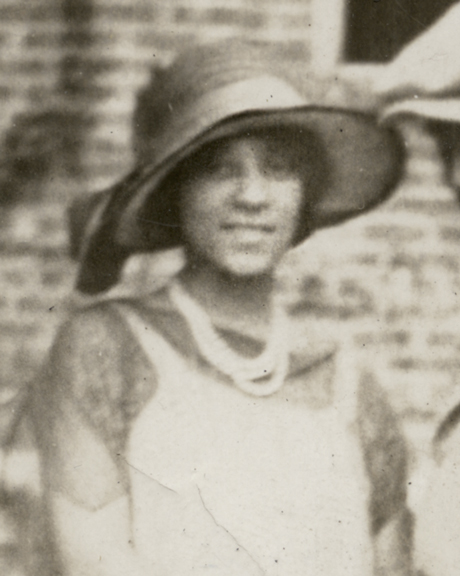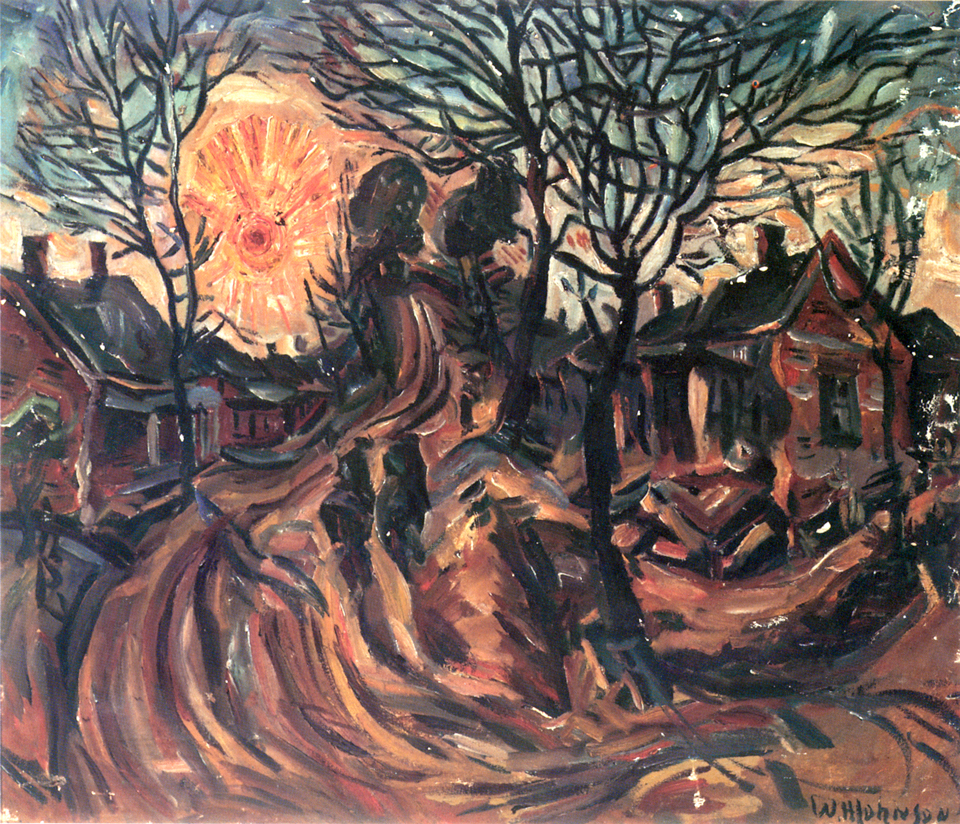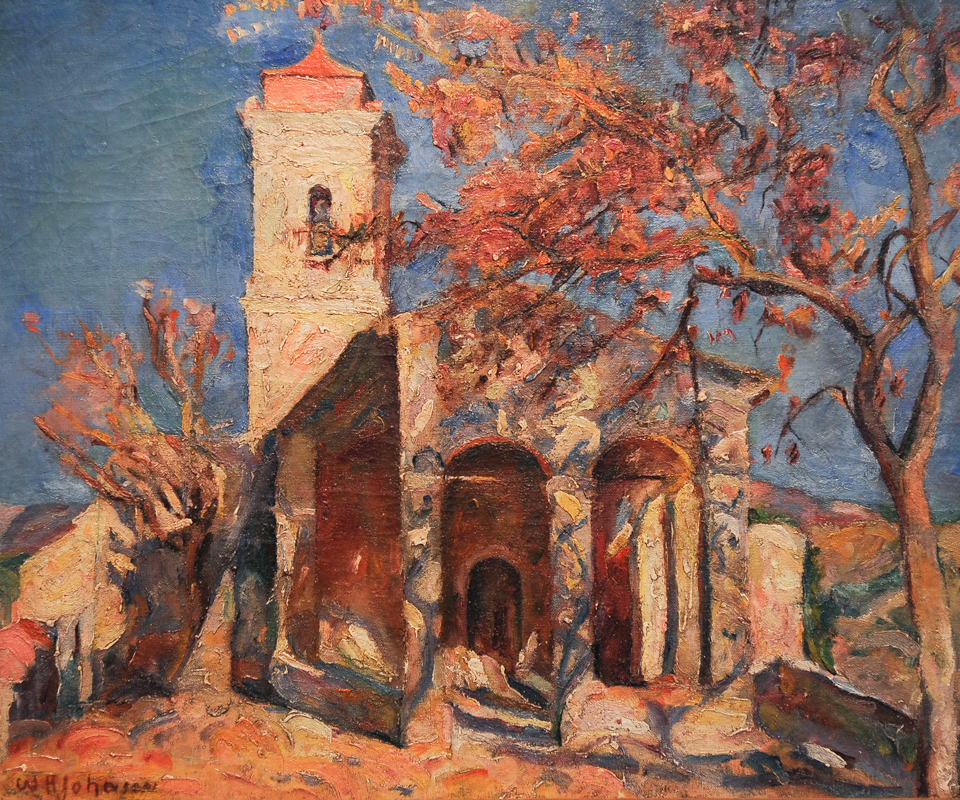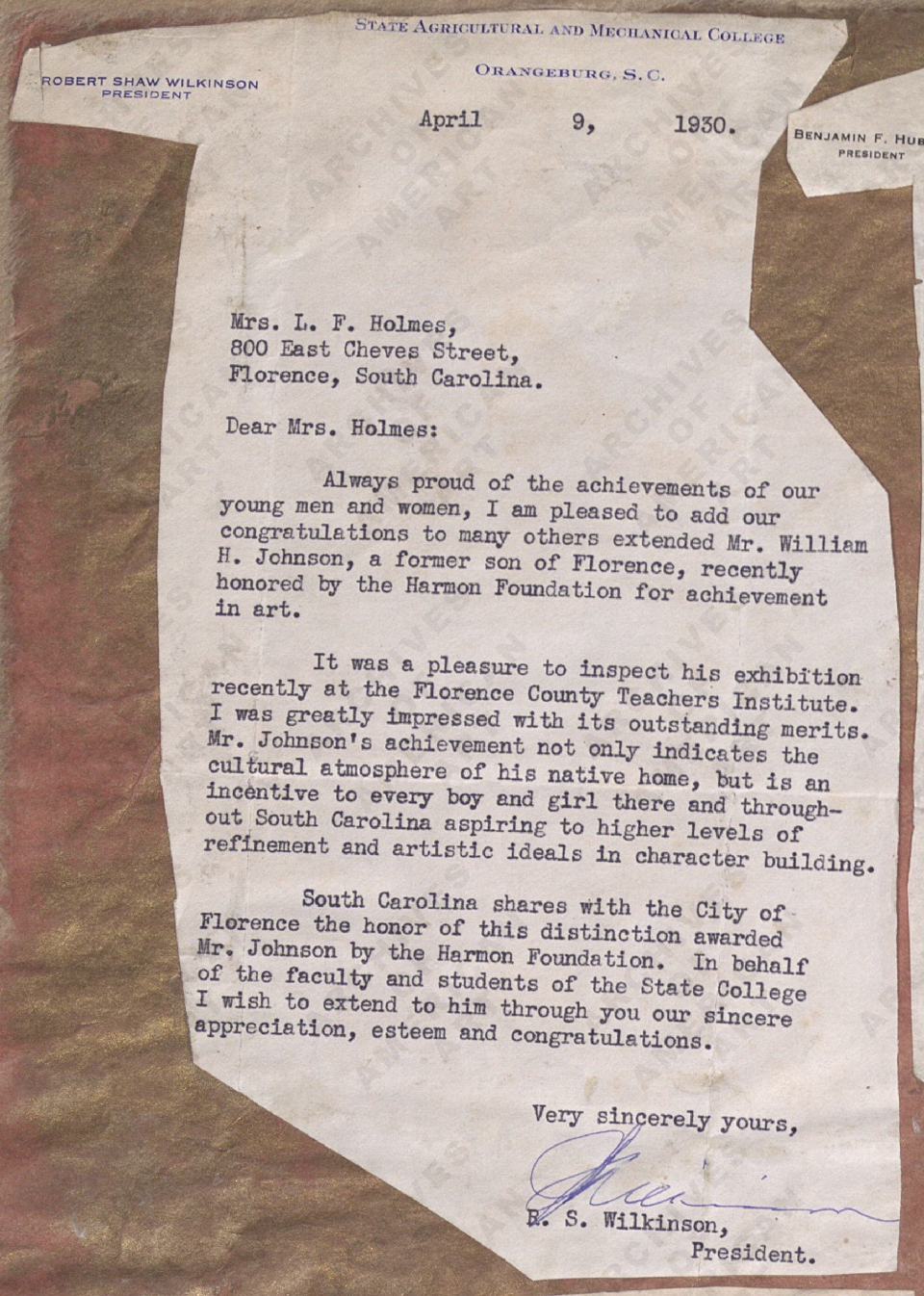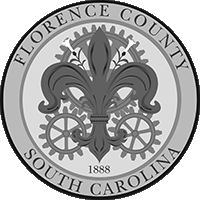In late February of 1930, a twenty-nine year-old William H. Johnson packed up his belongings from his humble Harlem loft in New York and boarded a train for a visit to his hometown of Florence, SC. The man who was returning to Florence was very different from the boy who left in 1918. During his twelve-year absence from Florence, Johnson had studied under Charles Hawthorne at the National Academy of Design in New York. During his time at the academy, Johnson had developed into a promising artist earning several accolades as a student. In 1926, Johnson’s mentor, Hawthorne had raised a thousand dollars to fund a study abroad for the young artist. Johnson spent the next two years in Europe working and exhibiting as an artist. It was during his travels that Johnson had met and fallen in love with Danish weaver, Holcha Krake. Upon his return to the United States in 1929, Johnson was encouraged by artist-friend, George Luks to enter his work for recognition into the Harmon Foundation Distinguished Achievements Among Negroes in the Fine Arts Field. Johnson was awarded the Harmon gold medal in the fine arts field January of 1930. After having won the prestigious award from the Harmon Foundation, Johnson was en route to see his family for a well-deserved homecoming.
William’s reunion with his family was likely an exciting moment in the Johnson family’s history. We know that upon his arrival in Florence, Johnson brought with him a large volume of his work. One can only imagine members of the Johnson family helping William transport trunks containing rolled up canvases and art supplies from the Atlantic Coast Line passenger station to the Johnson family home on Cox Street. Noted Johnson historian, Richard Powell (who interviewed Johnson’s family) indicates that William’s siblings: Lacy, Lucy, James, and Lillian had grown considerably since his departure in 1918, and that only William’s brother, Lacy had much memory of him. Powell also documents that the Johnson family had been learning to cope with the aftermath of Henry (Alice’s husband) Johnson’s debilitating stroke. William’s mother, Alice and brother, Lacy had become the primary source of the family income. William’s presence around the Johnson home probably had a very encouraging effect.
It is also understood that shortly after his arrival that the African-American community had arranged an entertainment in Johnson’s honor to celebrate his recent critical success. Though details documenting this public homecoming are scarce, Johnson was likely reunited with many familiar faces from his childhood at the celebratory event. Perhaps it was at this time that the artist resolved to capture the essence of his hometown during his visit. In his book, “Homecoming The Art and Life of William H. Johnson”, Richard Powell observed the following in a letter Johnson wrote from Florence to his sponsor Dr. George Haynes in New York, “I am feeling something… as I am surrounded by little negro boys and girls, hoping to abstract something of their ________ and putting on canvas.”
Johnson apparently made good on this statement in his letter to George Haynes as there are twelve known works that Johnson painted during his month long visit to Florence in 1930. The Smithsonian American Art Museum is currently in possession of six of these paintings.
1. Jim. Oil on canvas. 1930. Smithsonian American Art Museum.
2. Minnie. Oil on canvas. 1930. Smithsonian American Art Museum.
3. Girl in a Green Dress (Portrait Study No. 22). Oil on canvas. 1930. Smithsonian American Art Museum.
4. Portrait Study No. 16. Oil on canvas. 1930. Smithsonian American Art Museum.
5. Little Girl. Oil on canvas. 1930. Smithsonian American Art Museum.
6. Portrait. Oil on canvas. 1930. Smithsonian American Art Museum.
Of the Smithsonian American Art Museum’s six portraits, three of the portraits’ subjects have been identified.
Jim is a portrait of William’s sixteen year-old brother, James Johnson. Jim was likely painted in the Johnson family home at 925 Cox Street.
Minnie is the portrait of Minnie Kirkland, the owner and chef of Florence’s National Café, a popular local restaurant that was once located at 101 E. Marion Street.
Girl in a Green Dress is a portrait of Bertha Brooks White, the wife of Lucius White who was the owner of Miller’s Grocery previously located at 1106 E. Kershaw Street. According to Gwendolyn White Robertson, the daughter of the subject of Girl in a Green Dress, the painting was painted at their home located at 212 E. Kershaw Street in east Florence. Though the young subjects of Portrait Study No. 16., Little Girl., & Portrait. remain a mystery, it appears that these three portraits were painted near the same time as the previous three.
Johnson not only sought to capture the essence of Florence’s people on canvas, he was also compelled to paint several landscapes. Because Florence lacks the dramatic geographical features ideal for landscape painting the artist defaulted to painting the vibrancy of local sunsets and landmarks. The paintings Landscape with Sun Setting (Howard University), & Florence Sunset (Howard University) offer the viewer a glimpse into distinctly unique moments of Florence’s history as seen through Johnson’s eyes. The subject of Landscape with Sun Setting is likely the intersection of Cox Street and Johns Alley where Johnson’s family lived in 1930.
Landscape with Sun Setting, Florence, S.C.
Oil on canvas
1930
Howard University, Washington, D.C.
The Smithsonian American Art Museum’s Jacobia Hotel is another local example of Johnson’s landscape painting during his expressionist period. Built in 1857 on the corner of Church and Front Streets, the Jacobi Hotel (commonly referred to as ‘Jacobia’ by elder locals) was one of the first successful local business ventures to spring up at the intersection of the railroads during the town’s earliest years. By the time Johnson painted Jacobia Hotel in 1930, the Jacobi property had already fallen into a state of decline. The hotel turned boarding house was reportedly to have often been the home to prostitution. According to an interview with Lillian Johnson Cooper conducted by Richard Powell in 1985, Johnson’s sister indicated that William was “almost arrested” by local authorities while painting Jacobia Hotel, but Bill Covington who was Alice Johnson’s boss at the nearby Y.M.C.A., intervened and persuaded the authorities not to arrest the artist. The exact reason for Johnson’s near arrest has been the subject of conjecture among historians, but the common belief is that local authorities didn’t appreciate the ‘negro’ artist creating a scene while painting in the street. Regardless of the reason behind this altercation, it is certain that Johnson’s relationship with Covington proved to be a valuable one during his short stay in Florence.
Jacobia Hotel
Oil on canvas
1930
Smithsonian American Art Museum
Johnson’s mother Alice, who was well known in the community for her work at the local Y.M.C.A., had arranged with her boss and Y.M.C.A. secretary, Bill Covington, for an exhibition of her son’s work at the Y.M.C.A. Covington was quoted in the Florence Morning News as saying that, “he felt sure the public would be interested in viewing his (Johnson’s) work”. On Tuesday April 15th, 1930 between the hours of 3 P.M. and 6 P.M., Johnson held the briefest of exhibitions at the Atlantic Coastline Y.M.C.A. in Florence. The Y.M.C.A. showcase consisted of 135 paintings; which is exemplary of Johnson’s singular focus as an artist. Despite Johnson’s undeniable brilliance, the exhibition’s schedule is also indicative to the level indifference that the majority of Florence had for art, much less the paintings of a local African-American.
Chapel of Notre Dame de la Protection, Cagnes-sur-Mer
Oil on canvas
1927
Collection of the Trustees of the Florence Museum
The Trustees of the Florence Museum’s, Chapel of Notre Dame de la Protection, Cagnes-Sur-Mer was one of the 135 paintings exhibited at the Y.M.C.A show. As a gesture of gratitude, Johnson gave the painting to a young man named William Gardner who assisted the artist in hanging the show. Through a serendipitous series of events, The Trustees of the Florence Museum were able to purchase the painting for the museum’s collection.
For nearly twenty years, Johnson’s three-hour Y.M.C.A. show has been understood to have been the artist’s only exhibit in his hometown during his lifetime. Recently discovered evidence informs that Johnson actually had exhibited his work in Florence nearly two months prior to the Y.M.C.A. exhibit. On Thursday February 20th, 1930, The Florence Morning News published the following article:
“County Negro Teachers To Meet Here On Saturday”
“The Florence County Negro teachers association will meet in Florence Saturday February 22 at 11 o’clock with Dr. R. S. Wilkinson president of State College at Orangeburg as the principal speaker. The meeting will be held in the auditorium of East Side school. The Rev J. E. Thomas will preside and he will be assisted by Supervisor N. J. Cohen. It was announced that W. H. Johnson famous negro artist of New York City, who is now visiting his mother here, would be present and would exhibit some of his pictures.”
Additionally, there is a letter found in the Smithsonian’s American Art Archives W. H. Johnson Papers Online confirming that Johnson in fact exhibited at this particular event. The letter is written by the principal speaker, R. S. Wilkinson to Louise Fordham Holmes, who in all likelihood organized the Florence County Teachers Institute event.
R. S. Wilkinson’s letter to L. F. Holmes from Johnson’s personal scrapbook
courtesy of William H. Johnson papers, 1922-1971, bulk 1926-1956
Archives of American Art, Smithsonian Institution
Some local narratives of Johnson’s life have portrayed the artist’s 1930 visit in the light of the ‘tragic artist’ archetype. Much of the William H. Johnson’s later life is no doubt characterized by a variety of immensely tragic circumstances, but in 1930 these misfortunes had yet to arrive in the artist’s life. At the time of his 1st return visit to Florence, Johnson’s life is anything but tragic in fact his future seems full of promise.
If you would like to learn more about William H. Johnson or his hometown of Florence SC, check out the following sources used to help author this post:
Books:
Homecoming The Art & Life of William H. Johnson, by Richard Powell.
William H. Johnson: Truth Be Told, by Steve Turner & Victoria Dailey.
Rise Up So Early A History Of Florence County South Carolina, by G. Wayne King.
Village to City Florence SC 1853-1893, by Eugene N. Zeigler.
Web Resources:
The National Museum of American Art, Website, Smithsonian Institution: William H. Johnson Digital Collection.
The Archives of American Art, Website, Smithsonian Institution: William H. Johnson papers, 1922-1971, bulk 1926-1956.
Miscellaneous Resources:
“Young Negro Wins $400 Fine Arts Prize”
article from The Florence Morning News Saturday January 4th, 1930.
“Harmon Award Winner On Visit To Home City”
article from The Florence Morning News Tuesday February 18th, 1930.
“County Negro Teachers To Meet Here On Saturday”
article from The Florence Morning News Thursday February 20th, 1930.
“Y.M.C.A. Officers Announce Exhibit by Negro Artist: William Johnson, Florence Man To Show 135 Paintings.”
article fromThe Florence Morning News Sunday April 13th, 1930.
“Artist Johnson”
article from The Florence Morning News Tuesday April 15th, 1930.
“William H. Johnson: Artist Florence Life Recalled”
article from The Florence Morning News Wednesday November 3rd, 1971.



